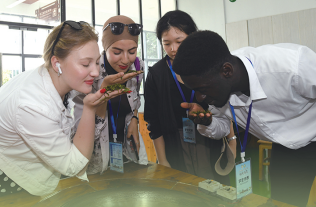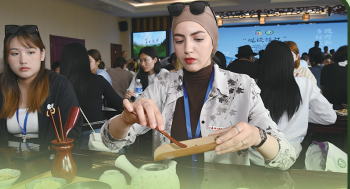

For example, Lanh shared with Luo that Vietnam, the world's fifth-largest tea producer and exporter, has significant sales of green tea and oolong tea in Southeast Asia. "Vietnamese people also love drinking tea, and we have a longstanding tea culture. However, unlike the Chinese habit of drinking hot tea, many Vietnamese prefer it cold," she explained.
Lisovenko said that tea was introduced to Russia from China in the 17th century and quickly became a popular beverage. She observed that both cultures value the social aspect of tea drinking, but their preferences differ.
"Russians typically drink black tea, while Chinese people drink a wider variety of teas, including green tea, white tea, and oolong tea," she said. "Additionally, Russians often add sugar or honey to their tea, while Chinese people typically drink their tea plain."
These young individuals also organized an evening event where they recited Chinese poems about agriculture. The event took place at a local farm. Luo observed that many farmers, having finished their day's work in the fields, brought their families to join the audience.
"It was truly a beautiful scene: people of all ages, from different cultural backgrounds and various identities, immersing themselves in China's thousands of years of agricultural civilization," he said.
This is probably why Sanchez believes that these exchange activities are so important. "They helped us understand China, its culture, its way of thinking, and how the locals express themselves. More importantly, they taught us how to learn from and respect other cultures," he said.
